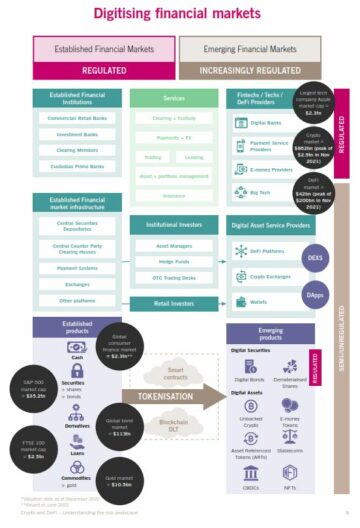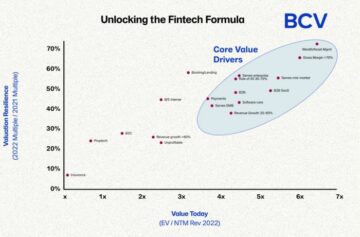Guest Post | March 15, 2023

Around 65% of businesses rely on geographic information systems (GIS) to unlock “the power of where”, otherwise known as location intelligence, and the many benefits it holds for any venture’s success. It is achieved by visualizing and analyzing geospatial data to gain insights into what is happening, establish the causes of it, respond by making informed decisions, and potentially predict future outcomes. GIS technology has become a go-to solution that covers a variety of business needs, such as developing new markets, real-time asset management, solving supply chain issues, and repairing critical infrastructure to name a few.
What is GIS?
A geographic information system is a computer system used to collect, analyze, manage, and visualize a multitude of geographical data. This data represents a combination of spatial data, which is referenced to a certain location on Earth, and attribute data describing or measuring it. Imagine a building on a city map: the spatial data are its exact geographical coordinates (latitude and longitude), while background information about the number of floors, construction year, and residential capacity is the attribute data. Together they enable GIS technology to be an efficient problem-solver, delivering actionable insights and driving transformation across a wide range of industries.
GIS for agriculture
Agriculture is one of the many domains where GIS has been making an impact to tackle the existing challenges. The limited scope of arable lands, climate change, and water scarcity are hog-tying farmers, who are major global food producers, affecting crop productivity and pushing them toward looking for more efficient, sustainable ways to manage fields. While the use of GIS in farming is not something new, the technological advancements of recent years have increased the scope of GIS applications in agriculture.
Crop monitoring and prediction of yield
Remote sensing and GPS serve as supporting technologies providing input data on cultivated crops and their environments for agriculture GIS software to analyze and display it for further use. Satellite and UAV images capturing the reflectance of plant canopies at multiple wavelengths allow us to calculate vegetation indices. The calculations are then visualized to estimate overall crop health, detect pest infestations and diseases, heat and cold stress, as well as any other deviations from expected development. Farmers can take immediate action to prevent crop losses and boost productivity. Using GIS in agriculture also includes spatiotemporal analysis of data across several growing seasons: it enables specialists to trace changes in crop health and make crop yield predictions before harvesting.
Precision farming
This is by far one of the most buzzing GIS applications in agriculture: achieving cost-efficient and sustainable field management through the use of geospatial data and technologies coupled with agronomic knowledge. Precision agriculture is based on the idea of considering the variability of crop production factors, which is key to optimal inputs and water management. GIS and remote sensing data-derived insights power the variable rate technology (VRT), which helps to prescribe the right quantities of pesticides, herbicides, fertilizers, and watering required to maintain crop development in the exact field zone at the exact time.
Soil health monitoring for boosting fertility
Fertile soil is soil that receives just the right amount of nutrients and water it needs to support adequate crop development. Waterlogging, abuse of chemicals, overgrazing, and soil erosion altogether affect fertility. Soil health and fertility mapping are among critical GIS applications in agriculture: it allows farmers to come up with field-specific fertilizer prescriptions to maintain or maximize crop productivity and get insights into soil-specific crop suitability.
More industries where GIS helps
The applications of GIS in farming show that this technology works wonders with spatial data, which makes up about 80% of the information used by businesses in their research and analyses. Let’s take a look at other examples of how “the power of where” helps companies thrive.
- Banking institutions can map out demographics and tailor their offerings to meet local needs (e.g. focus on car insurance services in districts with high car ownership rates).
- GIS enables responsible construction so that urban city planners could measure the potential damage a new building project can bring to local historical structures and nature.
- The public safety sector relies on GIS technology to map out places prone to natural disasters and posing great risks for people.
- Geospatial data aids in afforestation and tree regeneration by identifying plots with proper growing conditions based on annual rainfall, dry season length, and various other factors.
The value of GIS mapping
GIS displays layers of geographical data in form of maps – a digestible format that facilitates insights, revealing otherwise unseen trends and patterns. GIS maps have become a thing for everyone, from city planners and engineers to mere tourists.
In terms of GIS in agriculture, mapping is most often implemented in estimating crop productivity to visualize field zones based on how well they perform. This information enhances soil sampling and serves as a guide to proper nutrient application.
In daily life, GIS maps help tourists find their current whereabouts or the nearest bus stop based on GPS technology and global maps, such as Google Maps.
For scientists, GIS is a powerful tool that integrates multiple sources of data about the studied object or phenomenon in one place.
What the future holds for GIS?
GIS technologies keep evolving to bring more innovative solutions and are growing more mainstream.
See: How AI in Agriculture is Revolutionizing The Livestock World
Experts have named several prospected GIS trends for the coming year, such as the increased focus on smart city planning, the growing reliance on crowdsourced data supplied by users, the improvement of asset tracking in terms of security and efficiency, and the proliferation of the Internet of Things, AR and VR as means to improve location-based services and create engaging user experiences.
 The National Crowdfunding & Fintech Association (NCFA Canada) is a financial innovation ecosystem that provides education, market intelligence, industry stewardship, networking and funding opportunities and services to thousands of community members and works closely with industry, government, partners and affiliates to create a vibrant and innovative fintech and funding industry in Canada. Decentralized and distributed, NCFA is engaged with global stakeholders and helps incubate projects and investment in fintech, alternative finance, crowdfunding, peer-to-peer finance, payments, digital assets and tokens, blockchain, cryptocurrency, regtech, and insurtech sectors. Join Canada’s Fintech & Funding Community today FREE! Or become a contributing member and get perks. For more information, please visit: www.ncfacanada.org
The National Crowdfunding & Fintech Association (NCFA Canada) is a financial innovation ecosystem that provides education, market intelligence, industry stewardship, networking and funding opportunities and services to thousands of community members and works closely with industry, government, partners and affiliates to create a vibrant and innovative fintech and funding industry in Canada. Decentralized and distributed, NCFA is engaged with global stakeholders and helps incubate projects and investment in fintech, alternative finance, crowdfunding, peer-to-peer finance, payments, digital assets and tokens, blockchain, cryptocurrency, regtech, and insurtech sectors. Join Canada’s Fintech & Funding Community today FREE! Or become a contributing member and get perks. For more information, please visit: www.ncfacanada.org
Related Posts
- SEO Powered Content & PR Distribution. Get Amplified Today.
- Platoblockchain. Web3 Metaverse Intelligence. Knowledge Amplified. Access Here.
- Source: https://ncfacanada.org/how-geographic-information-systems-help-businesses-thrive/
- :is
- $UP
- 1
- 10
- 100
- 2018
- a
- About
- abuse
- achieved
- achieving
- across
- Action
- advancements
- affect
- affecting
- affiliates
- agriculture
- AI
- aids
- All
- allows
- alternative
- among
- amount
- analysis
- analyze
- analyzing
- and
- annual
- Application
- applications
- AR
- ARE
- AS
- asset
- asset management
- Assets
- At
- attend
- background
- based
- BE
- become
- before
- benefits
- blockchain
- boost
- boosting
- bring
- Building
- bus
- business
- businesses
- Buzzing
- by
- cache
- calculate
- CAN
- Canada
- Capacity
- Capturing
- car
- car insurance
- causes
- certain
- chain
- challenges
- Chance
- change
- Changes
- chemicals
- City
- Climate
- Climate change
- closely
- collect
- combination
- come
- coming
- community
- Companies
- company
- computer
- conditions
- considering
- construction
- contest
- could
- coupled
- covers
- create
- critical
- Critical Infrastructure
- crop
- crops
- Crowdfunding
- cryptocurrency
- Current
- daily
- data
- deal
- decentralized
- decisions
- delivering
- Demographics
- developing
- Development
- digestible
- digital
- Digital Assets
- disasters
- diseases
- Display
- displays
- distributed
- domains
- driving
- dry
- e
- earth
- ecosystem
- Education
- efficiency
- efficient
- enable
- enables
- engaged
- engaging
- Engineers
- Enhances
- entered
- environments
- establish
- estimate
- Ether (ETH)
- Event
- everyone
- evolving
- examples
- exciting
- existing
- expected
- Experiences
- facilitates
- factors
- far
- farmers
- farming
- few
- field
- Fields
- finance
- financial
- Find
- fintech
- Fintech Funding
- floors
- flow
- Focus
- following
- food
- For
- form
- format
- Forward
- Free
- from
- funding
- further
- future
- Gain
- geographic
- geographical
- get
- Global
- google maps
- Government
- gps
- great
- Growing
- guide
- Happening
- Harvesting
- Have
- Health
- help
- helps
- High
- historical
- holding
- holds
- How
- http
- HTTPS
- idea
- identifying
- images
- immediate
- Impact
- implemented
- improve
- improvement
- in
- includes
- increased
- Indices
- industries
- industry
- information
- Information Systems
- informed
- Infrastructure
- Innovation
- innovative
- input
- insights
- institutions
- insurance
- Insurtech
- Integrates
- Intelligence
- Internet
- internet of things
- investment
- issues
- IT
- ITS
- Jan
- jpg
- Keep
- Key
- knowledge
- known
- lands
- large
- latitude
- layers
- Length
- Life
- Limited
- local
- location
- Location-Based
- Look
- looking
- losses
- Mainstream
- maintain
- major
- make
- MAKES
- Making
- manage
- management
- many
- map
- mapping
- Maps
- March
- Market
- Markets
- max-width
- Maximize
- means
- measure
- measuring
- Media
- Meet
- member
- Members
- monitoring
- more
- more efficient
- most
- multiple
- multitude
- name
- Named
- Natural
- Nature
- Need
- needs
- networking
- New
- Newsletter
- number
- object
- of
- Offerings
- on
- ONE
- opportunities
- optimal
- order
- Other
- otherwise
- overall
- own
- ownership
- page
- part
- partners
- patterns
- payments
- peer to peer
- People
- perform
- perks
- personal
- phenomenon
- Place
- Places
- planning
- plato
- Plato Data Intelligence
- PlatoData
- please
- Post
- Posts
- potential
- potentially
- power
- powerful
- Precision
- predict
- prediction
- Predictions
- prescribe
- Prescriptions
- prevent
- Prior
- Producers
- Production
- productivity
- project
- projects
- proper
- provides
- providing
- public
- Pushing
- range
- Rate
- Rates
- real-time
- receives
- recent
- Regtech
- reliance
- rely
- remote
- repairing
- represents
- required
- research
- residential
- Respond
- responsible
- revealing
- Revolutionizing
- risks
- s
- Safety
- satellite
- Scarcity
- scientists
- scope
- Season
- seasons
- sector
- Sectors
- security
- seeing
- serve
- serves
- Services
- several
- Share
- show
- sign
- smart
- Smart City
- So
- Social
- social media
- Software
- solution
- Solutions
- Solving
- something
- Sources
- Spatial
- specialists
- stakeholders
- Stewardship
- Stop
- stress
- studied
- success
- such
- suitability
- supplied
- supply
- supply chain
- support
- Supporting
- sustainable
- system
- Systems
- TAG
- Take
- technological
- Technologies
- Technology
- terms
- that
- The
- The Future
- the information
- their
- Them
- thing
- things
- thousands
- Thrive
- Through
- tickets
- time
- to
- today
- together
- Tokens
- tool
- toward
- trace
- Tracking
- Transformation
- Trends
- true
- UAV
- unlock
- urban
- us
- use
- User
- users
- value
- variety
- various
- vibrant
- Virtual
- Visit
- visualize
- vr
- Water
- watering
- wavelengths
- ways
- WELL
- What
- What is
- which
- while
- WHO
- wide
- Wide range
- will
- win
- winners
- with
- works
- world
- year
- years
- Yield
- Your
- zephyrnet
- zones














